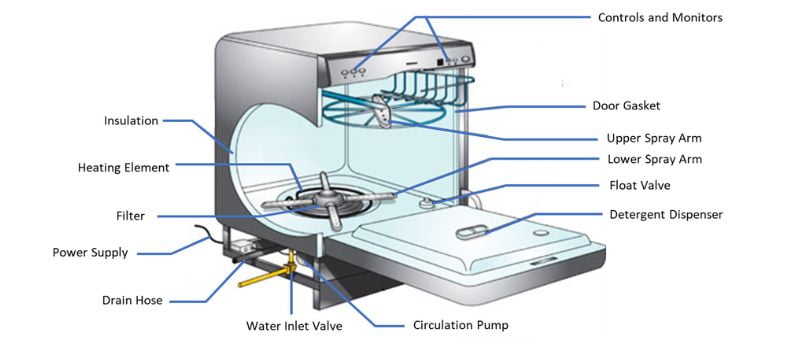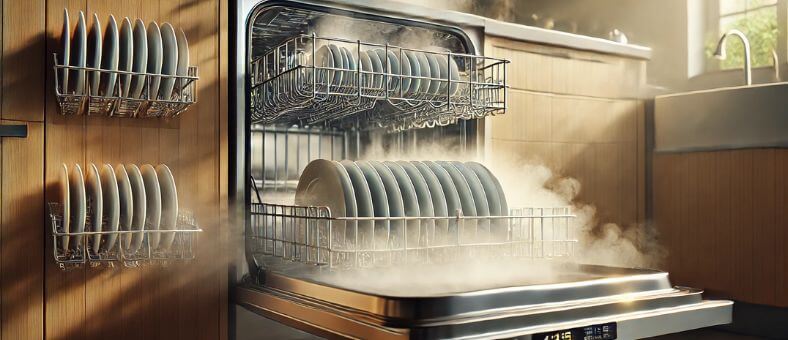Ever had a lovely dinner but then cringed at the sight of a sink full of dirty dishes? Or maybe you’ve spent your precious weekend elbow-deep in soapy water instead of unwinding or doing something you love. We’ve all been there, and let’s be honest, hand-washing dishes can be a real chore. Thankfully, this can be avoided by using a dishwasher. Now, you might ask, “What is a dishwasher?” and “Can it save me from this struggle?”
“A dishwasher is a machine designed to automatically clean dishes, utensils, and cookware by spraying them with water and detergent and then rinsing and drying them.“
Good news! A dishwasher is more than just a large kitchen appliance; it’s your ticket to freedom from endless dishwashing, your ally in maintaining a clean, orderly kitchen. This magical machine takes your grimy plates, cups, and utensils and returns them to you spotless and gleaming, ready for your next culinary adventure.
But that’s just the beginning! Keep reading, and we’ll delve deeper into this time-saving marvel. We’ll explore how it works, its benefits, and why owning one could be one of the best decisions you make for your home and sanity. Ready to say goodbye to the dishwashing blues? Let’s dive in!
Cleaning Evolution Throwback
Early 20th-century homemakers had to combat mold using only essential soap and water. Today, we’ve got advanced detergents and fungicides. How lucky are we?
Table of Contents
How do dishwashers work? The 13 Steps Process

Let’s peek behind the scenes and uncover the inner workings of this magical appliance. So, you load up your dirty dishes, press a few buttons, and voila! But what happens next?
This step-by-step breakdown gives you a clear idea of how a dishwasher works magic, quickly transforming dirty dishes into spotless ones.
Step 01: Load the Dishes
Arrange the soiled dishes, cutlery, and other kitchen items inside the dishwasher. Ensure they are properly placed in the racks or trays for optimal cleaning.
Step 02: Add Detergent
According to your dishwasher model and personal preference, introduce an appropriate amount of dishwasher detergent into the assigned compartment. It’s important to choose a detergent designed specifically for dishwashers for the best results.
Step 03: Close the Door
Confirm that the dishwasher door is tightly shut, creating a watertight seal. This prevents any leakage during the operation.
Step 04: Water Intake
The dishwasher draws water into its tub. This water can be heated to a specified temperature to enhance the cleaning process, often depending on the chosen wash cycle.
Step 05: Mixing Detergent
The entering water blends with the dishwasher detergent, forming a potent solution that aids in breaking down food residue and stains.
Step 06: Water Jets Activate
Water jets, positioned in strategic spots within the dishwasher tub, spring to life, shooting the water-detergent mixture from various angles.
Step 07: Rotating Arms Distribute Water
The spray arms start to rotate, spreading the water and detergent solution uniformly over all the dishes, ensuring each dish gets the same level of cleaning.
Step 08: Cleaning Action
The force of water jets combined with the detergent solution works to detach food particles, grease, and stubborn stains from the dishes, providing a thorough cleaning.
Step 09: Filters Capture Debris
Integrated filters inside the dishwasher trap larger food debris or particles, stopping them from recirculating onto the clean dishes during the wash cycle.
Step 10: Final Rinse
The dishwasher sprays a fresh round of water over the dishes for the final rinse. This process thoroughly removes any leftover detergent and ensures the dishes are spotless.
Step 11: Drainage
The dishwasher’s efficient drainage system expels the dirty water through a hose, taking care of the wastewater disposal.
Step 12: Drying Process
Depending on the model, the dishwasher implements a drying mechanism, which can involve heating elements, condensation drying, or air drying to evaporate residual moisture, leaving the dishes dry and ready for use.
Step 13: Complete Cycle
Upon completion of the cleaning and drying stages, the dishwasher signals the end of the process. At this point, you can open the door and unload your sparkling, clean dishes, ready for the next meal.
What are the main parts of the dishwasher?

A dishwasher is a complex appliance that comprises several essential parts, each serving a specific function to ensure efficient cleaning. First, let’s explore the main components of a dishwasher, including the control mechanism, water intake valve, and circulation pump:
Control Mechanism
The control mechanism is the interface that allows users to operate the dishwasher. It typically consists of buttons, dials, or a digital display. Users can select various settings through the control mechanism, such as the type of wash cycle, temperature, delay start, and additional options like sanitization or extra drying. The control mechanism ensures easy use and customization according to specific cleaning needs.
Water Intake Valve
The water intake valve is a vital part of the dishwasher that regulates water flow. It is linked to the water supply line. It opens up when the dishwasher is turned on, enabling water to enter the tub at the right time and amount for optimal cleaning performance. When the desired water level is reached, the valve shuts down to stop additional water from entering.
Circulation Pump
The circulation pump is vital in cleaning a dishwasher. It is responsible for pumping water throughout the dishwasher and distributing it to the spray arms and other necessary areas. The pump propels the water with force, ensuring effective cleaning by removing food particles, grease, and stains from the dishes. It also helps properly function the filters and aids in the drainage process.
Additionally, here are a few other essential parts of a dishwasher:
Spray Arms
Spray arms are rotating components at the dishwasher’s bottom and top. They have small openings called water jets that spray water onto the dishes. The spray arms ensure thorough coverage, distributing water and detergent evenly and dislodging debris from the dishes.
Heating Element
The heating element is responsible for raising the water temperature in the dishwasher. It helps enhance the cleaning process by effectively dissolving detergent and removing stubborn stains. The heating element also aids in drying by evaporating moisture from the dishes at the end of the cleaning cycle.
Filters
Dishwashers are equipped with filters to capture food particles and debris during washing. These filters prevent larger particles from recirculating onto the dishes and clogging the spray arms or other components. The filters can be removable for easy cleaning and maintenance.
Drain Pump or Drain Hose
The drain pump or drain hose facilitates the removal of used water from the dishwasher at the end of the cleaning cycle. The pump or hose carries the wastewater away for proper disposal, ensuring the dishwasher is ready for the next use.
Time-Saving Wonders of a Dishwasher
Here’s an eye-opener – Using a dishwasher can save you up to 230 hours annually, essentially gifting you almost 10 full days back in your year!
Quick Guide: How to Install Your Dishwasher

Step 1: Get Set for Installation
Before you start installing your new dishwasher, there are a few things you need to do:
- Gather all the tools and materials you’ll need for the job.
- Clean out the area under the countertop where your dishwasher will be located. Make sure it’s free from any mess or obstacles.
- Confirm that the electrical and plumbing connections are good to go and easy to reach for the installation process.
Step 2: Positioning and Aligning Your Dishwasher
Next, for the built-in dishwasher, gently push your new dishwasher into its new spot (under the countertop, usually). Use a level to make sure it’s properly aligned both sideways and front to back. You can adjust the leveling feet if the dishwasher’s height needs a little tweaking. For a portable (countertop) dishwasher, find a flat surface to place, fix, and adjust the dishwasher.
Step 3: Hooking Up the Water Supply
Now, you’ll need to connect the water supply line to your dishwasher. You can use a flexible hose or copper tubing for this, linking the dishwasher’s water inlet valve with the shut-off valve (usually situated under the sink). Double-check that the connection is secure, and look out for any leaks when you switch the water supply on.
Step 4: Connecting the Drain Line
Time to attach your dishwasher’s drain line to the drain pipe or garbage disposal (mostly under the sink). Use a hose clamp or a hose connector to make sure the connection is watertight. Don’t forget to check the drain line for any kinks or obstructions that might interfere with proper drainage.
Step 5: Making Sure Your Dishwasher is Level
Check your dishwasher is level from every angle. There might be adjustable feet to raise or lower it as required. A level dishwasher improves efficiency and helps prevent water from pooling or leaking.
Step 6: Securing Your Dishwasher
To secure your dishwasher in its new home, you’ll need to attach it to the surrounding cabinets or countertop (mainly for built-in dishwashers). Be sure to follow the manufacturer’s instructions when installing mounting brackets or securing screws to ensure your dishwasher stays put.
Step 7: Putting Your Dishwasher to the Test
Once your dishwasher is snugly installed, turn on the water supply and look out for any leaks. To check everything is working as it should, run a test cycle on your dishwasher. Keep an ear out for any strange noises or problems, and adjust the settings as needed.
Essential Dishwasher Safety Tips: A Secure and Hassle-Free Experience

Read the Manual
Take time to fully understand your dishwasher’s manual. This will equip you with essential safety guidelines and operating instructions that can help optimize your appliance’s performance and longevity.
Load Dishes Properly
Ensure dishes are loaded correctly to avoid overcrowding, which can lead to inadequate cleaning. Also, properly securing dishes can prevent potential damage or injury caused by dislodged items during the wash cycle.
Use Dishwasher-Safe Items Only
Load your dishwasher only with items that are explicitly labeled as dishwasher-safe. This helps to prevent potential damage, melting, or deformation of items that cannot withstand the high temperatures and vigorous water action in a dishwasher.
Scrape Off Excess Food
Before loading dishes, remove larger food particles to maintain the dishwasher’s water circulation and cleaning efficiency. This simple step can prevent clogging and help your dishwasher perform its best.
Be Cautious with Detergents
Always adhere to the recommended detergent guidelines specified by your dishwasher manufacturer. Using the right amount can prevent issues such as leaks, excessive suds, or insufficient cleaning.
Avoid Opening During Operation
Avoid the urge to open the dishwasher while it’s in operation. Wait until the entire cycle is complete to prevent potential burns from hot steam and water, or injuries from sudden spurts of water.
Let Dishes Cool Before Unloading
Allow your dishes to cool down for a few minutes after the cycle is complete. This helps avoid burns from handling hot dishes and also prevents accidental drops of items due to heat-induced discomfort.
Keep Children and Pets Away
Always ensure that children and pets maintain a safe distance from the dishwasher during its operation. This can prevent accidental burns or injuries caused by curious tampering or unexpected opening of the dishwasher.
Regular Maintenance
Undertake regular cleaning of your dishwasher and follow the maintenance instructions provided by the manufacturer. This proactive care will keep your dishwasher running smoothly, extending its lifespan and ensuring consistently clean dishes.
Dishwashers Buying Guide

What are the different types of dishwashers?
Discover a world of diverse dishwasher options designed to cater to your unique preferences and needs.
At WashDryDazzle, we offer a wide selection of dishwashers tailored to every kitchen setup, lifestyle, and budget.
Explore Dishwasher Options That Fit Your Lifestyle »
Let’s take a closer look at some of the most popular types to help you find the right one:
Front Control Dishwashers
These dishwashers have the control panel on the front of the appliance, typically on the top edge of the door. They offer convenient access to the controls and are easy to operate.
Top Control Dishwashers
Unlike front-control dishwashers, top-control models have the control panel on the top of the door. This design provides a sleek and streamlined look, as the controls are hidden when the door is closed.
Portable Dishwashers
Portable dishwashers are freestanding units that can be moved around the kitchen as needed. They usually have wheels for easy mobility and connect to the sink faucet for water supply. Portable dishwashers are a suitable option for those who don’t have a dedicated space for a built-in dishwasher.
Countertop Dishwasher / Compact Portable Dishwasher
A countertop dishwasher, also referred to as a compact portable dishwasher, is a small dishwasher that fits on top of a counter or any other flat surface. It’s an excellent solution for those who have a kitchen with limited space or who don’t have the ability to install a full-sized, built-in dishwasher.
Built-In Dishwashers
Built-in dishwashers are a type of dishwasher that is installed directly into your kitchen cabinetry, usually below the countertop. They are designed to blend seamlessly with the rest of your kitchen design and provide a more streamlined and uniform look, as they often match the cabinetry or appliances.
Tall Tub Dishwashers
They have a larger internal capacity, allowing them to accommodate taller items such as pots, pans, and baking sheets. This design offers more flexibility in loading and can handle larger loads of dishes.
Third Rack Dishwashers
Some dishwashers feature an additional third rack above the traditional upper and lower racks. The third rack provides extra space for utensils, cutlery, or small items, maximizing the dishwasher’s capacity and organization.
What are standard dishwasher sizes and Capacities?
Common dishwasher sizes can vary, but here are the typical dimensions for compact, standard, and oversized dishwashers.
Compact Dishwashers: Dimensions and Capacity
Compact dishwashers typically measure 18 inches in width, stand between 34 to 36 inches tall, and have a depth of 24 inches. In terms of capacity, compact dishwashers can generally accommodate up to 8 place settings.
Standard Dishwashers: Dimensions and Capacity
Standard dishwashers are commonly 24 inches wide, around 35 inches tall, and have a depth of approximately 24 inches. They usually have the capacity to hold around 12 to 14 place settings, which makes them ideal for most households.
Oversized Dishwashers: Dimensions and Capacity
Oversized dishwashers, also known as large-capacity dishwashers, can have a width of 30 inches or more while maintaining a height and depth similar to standard models. These dishwashers are designed for larger families or those who frequently host guests and can hold up to 16 or more place settings.
Dishwasher Features That Matter
Considering these important features will help you choose a dishwasher that meets your cleaning needs, operates quietly, offers flexibility in loading, saves water and energy, and has a durable tub material for long-lasting performance.
Cleaning Power/Performance
Look for dishwashers with efficient cleaning mechanisms such as multiple wash cycles, high-pressure water jets, and specialized cleaning zones. Consider features like soil sensors that detect dirtiness and adjust the cleaning accordingly for optimal performance.
Noise Level
Dishwashers with lower noise levels provide a quieter operation, which is especially important for open floor plan kitchens or a more tranquil environment. Look for models with noise ratings below 50 decibels for a peaceful kitchen experience.
Flexibility
Look for adjustable racks, fold-down tines, and removable utensil baskets to accommodate various dish sizes and shapes. Dishwashers with flexible loading options allow for customization and efficient use of space.
Water and Energy Savings
Using energy-efficient dishwashers can reduce your water and energy consumption, leading to lower utility bills and a positive environmental impact. To ensure you get an efficient dishwasher, look for the ENERGY STAR label, which indicates that the appliance meets strict efficiency standards.
Tub Material
Stainless steel bs are durable, resistant to stains and odors, and can withstand high temperatures. Plastic tubs are generally less expensive and provide good insulation, reducing noise and heat loss.
Control Options
Front Panel Control
- Front panel control dishwashers have the control panel located on the front of the appliance, visible and accessible when the dishwasher door is open.
- These models typically feature electronic controls with digital displays and touchpad buttons on the front panel.
- Front panel control dishwashers offer a sleek and modern look, providing easy access to the control settings.
Top Control Dishwasher
- Top control dishwashers have the control panel located on the top edge of the door, hidden when the door is closed.
- The controls are accessible by opening the dishwasher door, allowing for a seamless and clean front appearance.
- These models often feature electronic controls with digital displays and touchpad buttons, providing a modern and intuitive interface.
Semi Hidden Control
- Semi-hidden control dishwashers combine front panel and top control design elements.
- The control panel is partially visible and accessible on the top front of the dishwasher door, providing a sleek and streamlined appearance.
- These models often feature electronic controls with digital displays and touchpad buttons for easy operation.
Filters
- Effective filters trap and remove food particles during the wash cycle.
- Multiple filters, including coarse and fine filters, ensure thorough cleaning.
- Removable filters make cleaning and maintenance convenient.
Sensor
- Sensor technology adjusts water usage, temperature, and cycle duration based on dirtiness.
- Soil sensors optimize cleaning while conserving energy and water.
- Reliable sensors reduce the need for pre-rinsing.
Cycle
- Dishwashers offer a variety of wash cycles for different cleaning needs.
- Common options include normal, heavy-duty, eco-friendly, quick wash, and sanitize.
- Specialized cycles like delicate or glassware cater to specific requirements.
- Customizable cycle options allow tailoring the wash to preferences.
A New Norm: Dishwashers in 75% of American Homes
Take a moment to consider this enlightening fact that currently, around 75% of households in the United States are equipped with a dishwasher.
What are some advantages and disadvantages of dishwashers?

Six Pros of Dishwashers
Time and Effort Saving
Dishwashers are a time-saving boon, especially for busy households. By taking over the chore of dishwashing, they free up your time and energy, making room for more essential or enjoyable activities.
Convenience
The convenience provided by dishwashers can’t be overstated. These appliances take over the mundane task of dishwashing, freeing you to focus on other chores, relax, or spend quality time with family and friends.
Hygiene
Dishwashers are champions at removing bacteria and germs from your dishes and utensils. By washing at high temperatures, they promote a healthier and more hygienic kitchen environment, thus contributing to your overall wellness.
Efficient Cleaning
Dishwashers deliver impressively clean results, easily tackling stubborn food particles, grease, and stains. They leave your dishes sparkling clean, providing a level of cleanliness that is hard to achieve with manual washing.
Conservation of Water and Energy
Dishwashers are designed to be water and energy-efficient. They typically use less water than hand washing, and many modern models have energy-saving modes. This efficiency makes them a responsible choice for environmentally-conscious households.
Preservation of Kitchenware
Dishwashers provide effective cleaning without the risk of breakage or damage that can occur with hand washing. They are gentle on delicate items, helping to extend the lifespan of your valuable kitchenware.
Seven Cons of Dishwashers
Initial Cost
Making the decision to purchase a dishwasher frequently entails a significant initial financial commitment. The cost can fluctuate greatly based on the model, ranging anywhere from $300 to $2000.
Water and Energy Consumption
While dishwashers are typically more water and energy-efficient than handwashing, using inefficient cycles or settings can lead to higher utility bills. Frequent use requires careful selection of cycles for efficient consumption.
Limited Capacity
A dishwasher’s capacity may not always be sufficient, particularly for larger households or occasions when you’re hosting gatherings. You might find yourself running multiple cycles or resorting to handwashing to deal with larger volumes of dishes.
Dishwasher Compatibility
Not all kitchenware is dishwasher-safe. Delicate items such as certain types of glassware, fine china, or wood utensils may need to be hand washed, which can add to your workload.
Pre-Rinsing and Loading
Heavy food debris may need pre-rinsing, and proper loading techniques are necessary. Pre-cleaning can add an additional step to the process, potentially leading to a time drain. Likewise, improper loading could result in the need to rewash the same dishes in the following cycle.
Noise Levels
Depending on the model, some dishwashers can produce noticeable noise during operation. This could be disruptive, especially in open-plan living spaces or during quiet periods, like nighttime.
Maintenance and Repairs
Regular maintenance and occasional repairs are a part of owning a dishwasher. This not only requires additional dedication to keep the appliance functioning optimally but it can also lead to financial investments related to its maintenance and occasional repairs.
Final Thoughts on What is a Dishwasher
As we conclude our exploration of “what is a dishwasher?”, let’s remember the excitement we’ve experienced while understanding their transformative role in our daily lives. Isn’t it astonishing how such a seemingly simple appliance can have a profound impact? Dishwashers, a brilliant demonstration of technological magic, have entirely redefined the exhausting chore of dishwashing. They save water, energy, and, most importantly, your invaluable time while delivering a cleaner job than manual washing.
Now, visualize the delight of a clutter-free kitchen, the gratification of shining dishes, and the luxury of spare time. It’s high time to turn this visualization into reality. Ditch the scrub and rubber gloves, embrace the tech revolution, and invest in a dishwasher. Trust me, this genius invention will become indispensable to your life. More than a purchase, it’s a lifestyle upgrade. So, let’s welcome this change and enjoy your dishwasher shopping!
At WashDryDazzle, we’re dedicated to providing essential insights that make your daily chores effortless. Dive deeper into our comprehensive Dishwasher Education hub to learn more.
Frequently Asked Questions (FAQs)
What are some popular dishwasher brands?
Some popular dishwasher brands included Bosch, Miele, KitchenAid, Whirlpool, and Samsung.
What types of dishwashers need to be installed?
Built-in dishwashers need to be installed directly into your kitchen cabinetry, usually below the countertop. Portable and countertop dishwashers do not require installation, as they can be moved around.
What is the capacity of a standard dishwasher?
Standard dishwashers typically can hold around 12 to 14 place settings, making them ideal for most households.
What type of detergent should I use for my dishwasher?
Always use detergents specifically designed for dishwashers. The choice between powder, tablet, or gel will depend on your personal preference and the recommendations of your dishwasher manufacturer.
Are dishwashers more efficient than hand washing?
Yes, dishwashers are generally more water and energy-efficient than hand washing. They also provide a more thorough cleaning and better eliminate bacteria due to higher washing temperatures.
What should I look for in dishwasher ratings?
Consider the cleaning power, noise level, flexibility, water and energy efficiency, and tub material. An Energy Star rating indicates that the dishwasher meets strict efficiency standards.
How long does a typical dishwasher last?
The lifespan of a dishwasher varies but typically ranges from 7 to 12 years with proper maintenance.
How long does a dishwasher cycle take?
A normal dishwasher cycle can range from 1 to 4 hours. The exact time depends on the selected wash cycle, soil level, and dishwasher model.
My dishwasher isn’t cleaning dishes properly. What can I do?
Check for common issues like overloading, improper loading, or low-quality detergent. You might also need to clean the dishwasher’s filter or spray arms. If problems persist, you may need to call a professional for a service.
What does a typical dishwasher warranty cover?
Most dishwasher warranties cover parts and labor for a certain period, usually one year. Some parts may have extended coverage. Always refer to your manufacturer’s warranty information for specifics.
How much water does a dishwasher use?
Modern dishwashers typically use less water than hand washing. The exact amount can vary, but on average, a standard dishwasher uses about 3-5 gallons of water per cycle.
What are some of the best dishwashers?
The best dishwasher for you will depend on your specific needs and preferences, including size, type, noise level, cleaning power, and budget. Always check the latest reviews and ratings for up-to-date recommendations.










